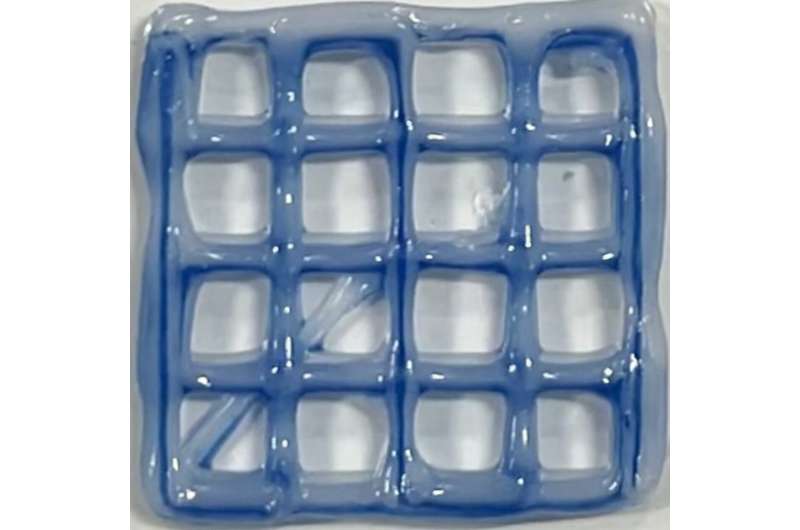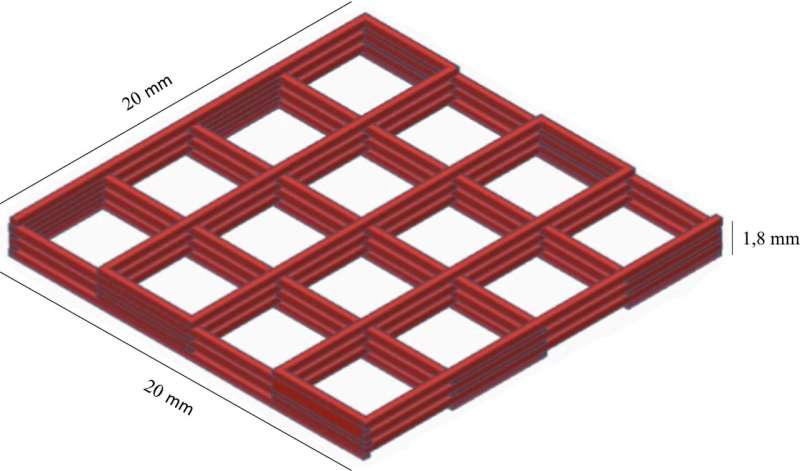This article has been reviewed according to Science X's editorial process and policies. Editors have highlighted the following attributes while ensuring the content's credibility:
fact-checked
proofread
Researchers develop 3D printed bandage that delivers innovative treatment for diabetic foot ulcers

Researchers from Queen's University Belfast have designed a new 3D printed bandage, known as a scaffold, which presents an innovative method of treatment to heal diabetic foot ulcers (DFUs).
The research is the first of its kind and is a breakthrough for diabetes management. The findings have been published in the journal Biomaterials Advances.
The new discovery combines lipid nanoparticles and hydrogels, which are used to create personalized skin-like 3D printed scaffolds. These scaffolds have the ability to release both a bulk and sustained release of antibiotic loaded molecules to treat diabetic ulcers.
This combination has been shown to greatly improve patient outcomes and has the added benefit of being a more sustainable, efficient and cost-effective method of treatment as these scaffolds in the future can be "easily" produced within the hospital setting.
This approach will also cut time for medical professionals and improve patient care, as the wound dressing can be monitored and provide the treatment needed without the need to be taken on and off repeatedly in order for the medical professionals to check the healing process.
Diabetes is a lifelong condition that causes a person's blood sugar level to become too high. It is among the top ten causes of deaths worldwide. DFUs are a serious complication of diabetes, affecting approximately 25% of diabetic patients. When identified, over 50% are already infected and over 70% of cases result in lower limb amputation.
As a strategy to manage DFUs, skin alternatives and wound dressings are successful treatments as they keep the wound environment "under control", while providing bioactive compounds that help to manage infection and inflammation and promote tissue repair.
This is a complex process that requires several combined therapeutic approaches. As a result, there is a significant clinical and economic burden associated in treating DFU. Furthermore, these treatments are often unsuccessful, commonly resulting in lower-limb amputation.

The use of drug-loaded scaffolds to treat DFUs has previously been shown to be successful by the same team. To create this new scaffold, the research team used a 3D bioprinting technique that combines, in one single filament, two different bioinks.
The inner core of the filament is a nanocomposite hydrogel that contains lipid nanoparticles encapsulated with thyme oil. The outer shell of the filament is represented by a hybrid hydrogel and enriched with free thyme oil.Thyme oil and other essential oils, have a promising future as an all-natural antibiotic replacement, helping address the issue of increasing incidences of antimicrobial resistance.
This combination provides two different release ratios of the drug molecule; a bulk release for the first 24 hours and a sustained release for up to 10 days. This enables an initial disease prevention post-administration, which may be the highest-risk time, followed by sustained infection prevention during the following days of antimicrobial efficacy.
Professor Dimitrios Lamprou, lead on the project and Chair of Biofabrication and Advanced Manufacturing from the School of Pharmacy at Queen's University Belfast, said, "This innovative, personalized, and sustainable approach, provides the healing needed for the diabetic foot ulcers, to avoid any complications, and enables doctors to monitor the healing constantly. This avoids needing to remove dressing constantly, which can provoke infection and delay the healing process. Medical professionals also do not need to change the drug dosage as this double release, supports that need."
Dr. Matthew Wylie, Lecturer from the School of Pharmacy at Queen's University Belfast and responsible for the in vitro antibacterial activity evaluation of these novel bandages, said, "Diabetic foot ulcers are chronic wounds highly susceptible to infection which can lead to limb- or life-threatening complications. Our natural liposomal antibacterial approach has shown promising initial antibacterial results highlighting the potential of this strategy to prevent bacterial colonization during the crucial early stages of wound healing, as well as longer term protection of the wound.
"Improved wound management will not only enhance patient quality of life but could reduce the need for traditional antibiotic therapy, a key aim in the fight against antimicrobial resistance development."
More information: Costanza Fratini et al, Combining microfluidics and coaxial 3D-bioprinting for the manufacturing of diabetic wound healing dressings, Biomaterials Advances (2023). DOI: 10.1016/j.bioadv.2023.213557



















